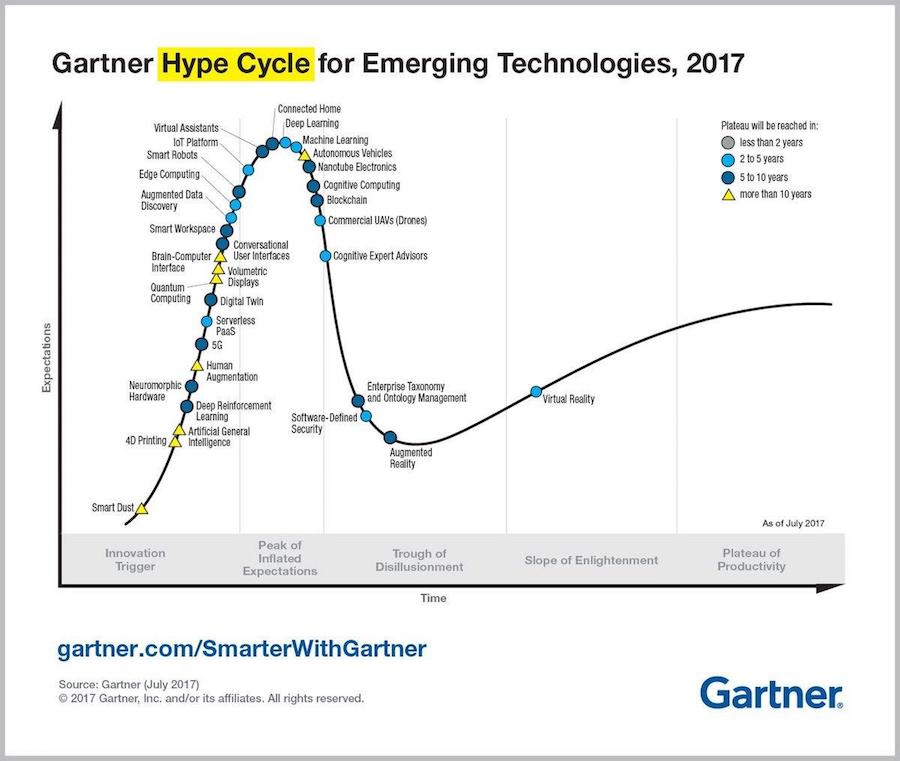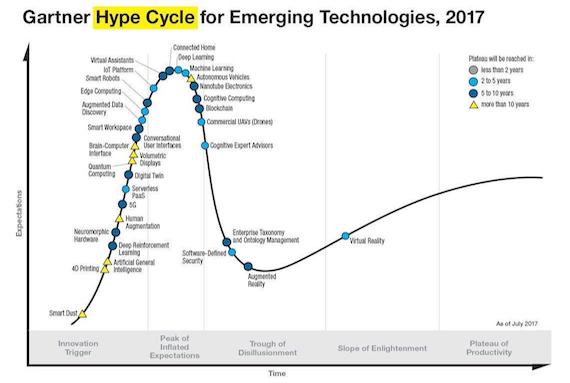Gartner Hype Cycle Suggests Another AI Winter Could Be Near

Gartner’s latest Hype Cycle for Emerging Technologies suggests that key artificial intelligence (AI) categories such as virtual assistants, deep learning, machine learning and cognitive computing are at their “peak of inflated expectations.” The Hype Cycle is a conceptual model designed to depict new technologies in terms of market perception. The five stages are:
- Innovation Trigger: technology advances spark interest in new opportunities, but technology is still unproven
- Peak of Inflated Expectations: market interest and news headlines herald a new era of computing, some use cases emerge but most buyers wait
- Trough of Disillusionment: technology buyers become disillusioned at the pace of progress and limitations for immediate application
- Slope of Enlightenment: more successful use cases emerge and companies engage in new proof-of-concept pilots
- Plateau of Productivity: “mainstream adoption starts to take off,” and the value of the technology becomes well understood and accepted
Placing these AI categories at the peak of inflated expectations suggests that disillusionment will soon follow. That means the perception of AI as a “hot technology” may soon give way to claims that it was over-hyped and impractical for most applications. This typically leads to lower venture capital financing, fewer corporate pilots and proof-of-concept projects along with a negative tone among the media.
Another AI Winter?
This is particularly concerning for some veterans of the AI space. AI has faced several boom-bust cycles that included a peak and trough, but did not march on to the plateau of productivity. Frank Chen from venture capital firm Andreessen Horowitz has a nice video overview of these cycles where he reviews three previous “AI Winters.” During the troughs or winters, AI funding dried up and projects were canceled until new innovations sparked a resurgence in AI optimism. Will this trough be different?
Some people believe that machine learning and deep learning techniques will make this trough different and shorter, if it arrives at all. Peter Cahill from Voysis suggest that Garner may be onto something with its current AI component designations.
I think that there is a lot of AI hype right now – a lot of people are using it as a buzz word and looking for what they can hit with “AI”. Even some companies are adding AI on their marketing materials without there actually being any modern form of AI in their products. I think that will fade out over the coming years.
At the same time, for the AI teams with substance, AI is currently used in a very small amount of the potential applications for it, so I can see that side of it growing. Today, AI is barely used in the vast majority of products (both consumer and enterprise), so surely this will increase, as modern AI technologies are already good enough to improve many things. I’ve been at WSJD for the past couple of days and I don’t think there was a single speaker who didn’t say the term ‘AI’ at least once. Surely that can’t always be the case.
This perspective seems right. AI is overhyped in the short-term, but there are many tangible applications today that may make the trough a short-lived era. A new “winter” doesn’t seem likely given how many use cases we see emerging in business each month.
Virtual Assistants from B2B and B2C Perspectives
This leads us to a discussion of virtual assistants. Gartner is focused on business applications and the virtual assistant category is likely targeting both chatbots and voice assistants. Chatbots were a big topic in 2016, but have been overtaken by voice technology and voice assistants in 2017. However, much of that is driven by the consumer focus around smart speakers such as Amazon Echo and Google Home. The business applications of voice are fewer and more limited. Cisco’s recent announcement of the Spark Assistant coming in 2018 is a good example. It includes all of about three features for controlling video conferencing equipment and making phone calls. The solution has an assistant, but nothing that will change the face of computing in the near term.
Chatbot-based virtual assistants are starting to show some tangible benefits, but they are not getting nearly as much hype as last year. Investors at a conference I attended in the Spring told a crowd of chatbot developers that they weren’t currently investing in chatbot business models and were more focused on voice. That wasn’t what many attendees wanted to hear. You could see that the VCs who were investing feverishly in chatbots in 2016 were anticipating a pull-back and looking for the next new thing.
The Emerging Technologies Hype Cycle is not a quantitative model. It’s a conceptual model that attempts to characterized B2B buyer sentiment. While B2C applications for voice assistants are taking off right now, Gartner’s forecast of a pending pullback among B2B buyers related to AI and virtual assistants is plausible and may just be right.









